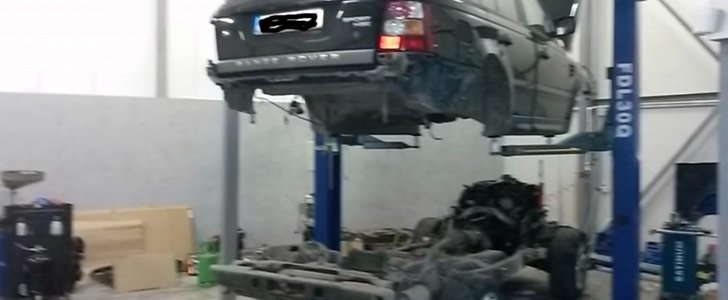You can change the oil or the spark plugs on a Range Rover Sport without removing the body. But to do more serious work, you need to separate the body from the frame. Of course, this is also true for the Discovery, but we thought these videos would be more controversial if we were showing a "luxury SUV."
Most modern vehicles feature unibody construction. That means the body is a structural piece that looks good and holds everything together like a big eggshell. But SUVs started out with ladder frame construction that separates the body and chassis into different pieces.
That's fine for an army off-roader where clearances are so big you can fit a man next to the engine, but not so much for a luxury truck. Up next, we're going to show you a few videos detailing how the Range Rover Sport's body is pulled off.
The mechanic needs to remove the headlights, front bumper, inner fenders, rear bumper, underbody shields and… then comes the hard part. All the mechanical connections between the body and the frame need to be removed. That includes the steering, brakes, the cap for the fuel tank, and lots of little cables.
The entire operation sounds like something that would take an entire team of skilled mechanics a week. But the maker of the first videos below says it only took one man one and a half hours to separate the body and another two and a half hours to put everything back together.
Normally, we'd let the problem slide because having a separate frame offers huge benefits when off-roading. However, the first-gen RR Sport is like the VW Golf of luxury SUVs, having sold around 350,000 units during its lifespan. That means thousands of trucks will have this tricky operation performed each time there's a trouble with the turbocharger or the engine needs to be rebuilt.
And trust us, mechanical problems are common for this model. We've heard people needing a full rebuild after the engine sucked in some sand, suspension couplings that made knocking sounds from the first month of ownership and, of course, the dreaded hydraulic lift suspension failure.
That's fine for an army off-roader where clearances are so big you can fit a man next to the engine, but not so much for a luxury truck. Up next, we're going to show you a few videos detailing how the Range Rover Sport's body is pulled off.
The mechanic needs to remove the headlights, front bumper, inner fenders, rear bumper, underbody shields and… then comes the hard part. All the mechanical connections between the body and the frame need to be removed. That includes the steering, brakes, the cap for the fuel tank, and lots of little cables.
The entire operation sounds like something that would take an entire team of skilled mechanics a week. But the maker of the first videos below says it only took one man one and a half hours to separate the body and another two and a half hours to put everything back together.
Normally, we'd let the problem slide because having a separate frame offers huge benefits when off-roading. However, the first-gen RR Sport is like the VW Golf of luxury SUVs, having sold around 350,000 units during its lifespan. That means thousands of trucks will have this tricky operation performed each time there's a trouble with the turbocharger or the engine needs to be rebuilt.
And trust us, mechanical problems are common for this model. We've heard people needing a full rebuild after the engine sucked in some sand, suspension couplings that made knocking sounds from the first month of ownership and, of course, the dreaded hydraulic lift suspension failure.




